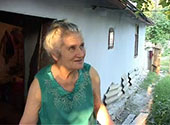
Evgeniia Krasner was born in 1936 in Shpykiv. She attended a Ukrainian school before the war and spoke Yiddish only among her family. Her father worked as an accountant in a sugar factory. During the war, she was imprisoned in the Pechera camp. After the war she was trained at the Cultural Institute of Kiev, from which she graduated as a librarian.
Other Interviews:
Zhenya's Gefilte FishThe Esebet (Reclining Bed)
Shpykiv, Ukraine
In Soviet times, while public displays of Jewish observance were heavily discouraged by state authorities, many Jews held on to the traditions of Passover, such as clandestinely baking and eating matzah. More than most other Jewish practices, Peysekh customs persisted among Soviet Jews, in part because of the symbolic content of the holiday's message of national liberation, and because of the memory of participation in the Seyder as children.
In the early years of the Soviet Union, the Jewish Sections of the Communist Party published so called Red Hagaddahs that tried to retell the Passover story as a story of the liberation of the proletariat from the oppression of the bourgeoisie. These Red Hagaddahs were widely distributed through Communist Party youth organizations. Almost none of the people we interviewed remembered the Red Hagaddahs. Instead, they recall traditional seders with their families, but often have difficulty recalling specific details of the ceremony. Evgeniia mentions how her father would read the Agude (Haggadah), and she would ask the Four Questions - in the clip, she begins reciting the first one, about the difference between eating khomets (chametz) and matzah. Going in reverse chronological order, Evgeniia then describes the preparations that went on before the holiday, first bedikes khomets and biur khomets (searching for remaining crumbs of bread and then burning them), and then the kashering (making kosher) of pots for Peysekh using a hot stone.
